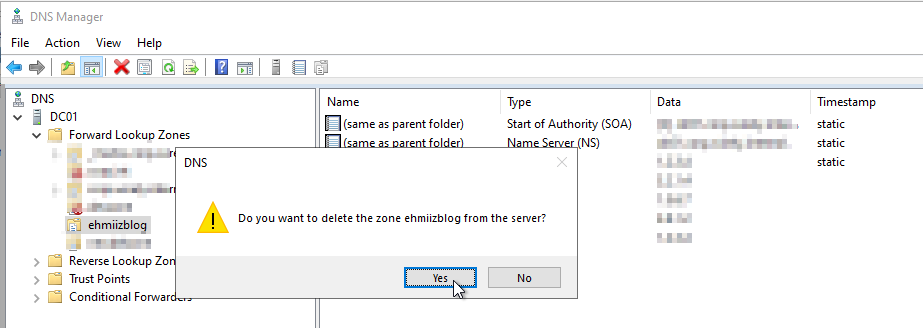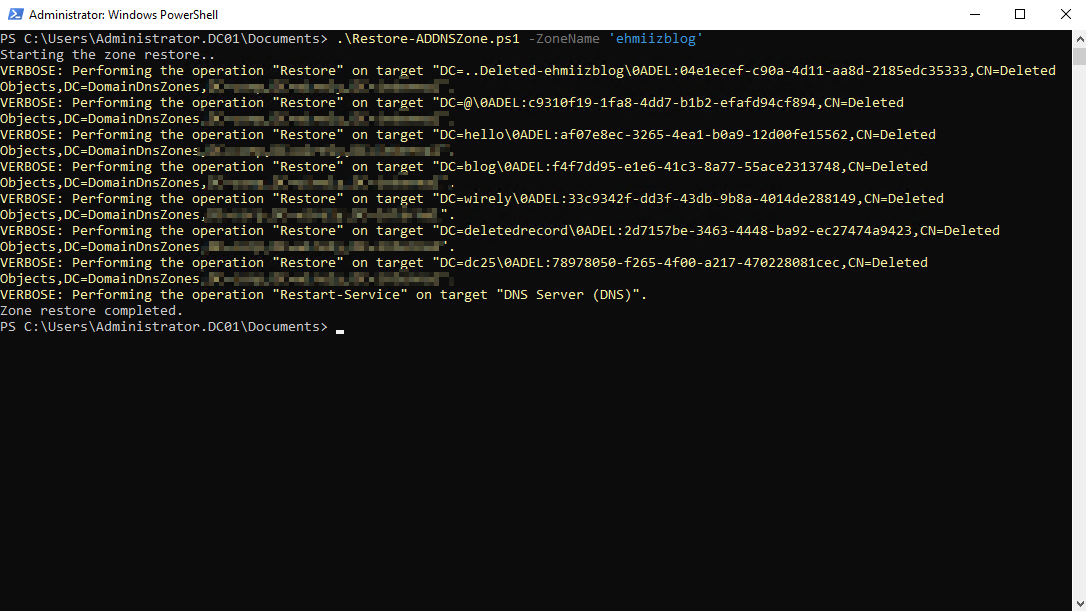PowerShell: Restore a DNS zone in Active Directory

Beware of the copy-paste trap! Always test public code in a safe, isolated environment before running it in production.
The fast version
Did someone just remove a very important AD-integrated DNS forward lookup zone for you?
Hang tight, and i’ll show you how to get it back.
- Using Domain Admin access rights, have any type of elevated PowerShell session open with the
DNSServerandactivedirectorymodule imported - Open notepad and save the script below as “Restore-ADDNSZone.ps1” at any location
- .\Restore-ADDNSZone.ps1 -ZoneName ‘myzone.org’
- If the zone was just deleted and the DC has access to the deleted zone objects, your zone will be restored. Verify by looking in DNS management.
If you’re not in a hurry, I recommend that you read what the script does first and test it in lab.

DNS Zone restore the simple way
I wrote a simple script to demonstrate how a DNS zone restore can be achived using the Restore-ADObject cmdlet:
- Importing Required Modules: Loads
ActiveDirectoryandDnsServermodules. - Setting Parameters: Allows specifying a DNS zone name, defaulting to “ehmiizblog”.
- Searching for Deleted Zone: Looks for the deleted DNS zone in known AD locations.
- Retrieving Deleted Records: Fetches resource records for the deleted zone.
- Restoring Zone & Records: Restores the DNS zone and its records to their original names.
- Restarting DNS Service: Restarts the DNS service to apply changes.
- Output Messages: Provides feedback on the restoration progress and completion.
| #Requires -Version 5.0 -Modules DnsServer, ActiveDirectory | |
| param( | |
| [string]$ZoneName = "ehmiizblog" | |
| ) | |
| <# | |
| .Synopsis | |
| Restores a DNS zone using the DNSServer & ActiveDirectory module | |
| .DESCRIPTION | |
| An AD-integrated DNS primary zone can be quickly restored, with | |
| all it's records using this script. The script looks in known | |
| locations for the deleted zone and it's resource records (`dnsZone` | |
| & `dnsNode` objects). The restored zone is also renamed to it's | |
| original name. | |
| .EXAMPLE | |
| .\Restore-ADDNSZone.ps1 -ZoneName 'myzone.org' | |
| .NOTE | |
| Run this in a lab setting before you try it in prod | |
| #> | |
| Import-Module ActiveDirectory, DnsServer -ErrorAction Stop | |
| $DomainDN = (Get-ADDomain).DistinguishedName | |
| [System.Collections.ArrayList]$global:DeletedZoneDN = @( | |
| "CN=MicrosoftDNS,CN=System,$DomainDN" | |
| "DC=DomainDnsZones,$DomainDN" | |
| ) | |
| function Get-DeletedDNSZone { | |
| param( | |
| [string]$ZoneName = $ZoneName | |
| ) | |
| $DeletedZoneDN | ForEach-Object { | |
| # Define the lookup parameters | |
| $FindZoneSplat = @{ | |
| LDAPFilter = "(&(name=*..Deleted-$($ZoneName)*)(ObjectClass=dnsZone))" | |
| SearchBase = $_ | |
| IncludeDeletedObjects = $true | |
| Properties = "*" | |
| } | |
| # Look for the zone | |
| $LookForTheZone = Get-ADObject @FindZoneSplat | |
| if (-not [System.String]::IsNullOrEmpty($LookforTheZone)) { | |
| $LookForTheZone | Select-Object -First 1 | |
| } | |
| } | |
| } | |
| function Get-DeletedDNSZonesResourceRecords { | |
| # Get the deleted DNS zone | |
| $DeletedZone = Get-DeletedDNSZone | |
| if ([string]::IsNullOrEmpty($DeletedZone)) { | |
| Write-Warning -Message "Zone: $ZoneName not found." | |
| Break | |
| } | |
| # Convert WhenChanged to UTC and format to LDAP Generalized Time | |
| $DeletionTimeStamp = $DeletedZone.whenChanged | |
| # Iterate over each DeletedZoneDN | |
| $DeletedZoneDN | ForEach-Object { | |
| Get-ADObject -Filter { WhenChanged -ge $DeletionTimeStamp -and ObjectClass -eq 'dnsNode' -and isDeleted -eq $true } -SearchBase $_ -IncludeDeletedObjects | |
| } | |
| } | |
| $TheDeletedZone = Get-DeletedDNSZone | |
| $TheDeletedRecords = Get-DeletedDNSZonesResourceRecords | |
| if ($TheDeletedZone -and $TheDeletedRecords) { | |
| Write-Output "Starting the zone restore.." | |
| $TheDeletedZone | Restore-ADObject -NewName $ZoneName -Verbose -ErrorAction Stop | |
| $TheDeletedRecords | Restore-ADObject -Verbose -ErrorAction Stop | |
| Restart-Service DNS -Verbose -ErrorAction Stop | |
| Write-Output "Zone restore completed." | |
| } |
Didn’t work, what now
If you have access to a backup of the DNS server, you can export a .dns file and rebuild the zone on the production server.
The steps below will vary largely on your situation, but it might give you an idea of the process:
Sidenote:Tthe “Above explained” points adds further explenation to the command we ran in the previous step.
- Connecto to the backup DC
- Export the zone using
dnscmd:dnscmd /ZoneExport zone.org zone.org_backup.dns - Attached a disk or storage device to the DC, mount it and moved the newly created zone data file
zone.org_backup.dns - Attached the disk to the PDC
- Copied the file to system32\dns
- Create the new zone using
dnscmd:dnscmd SERVER /zoneadd zone.org /primary /file zone.org_backup.dns- Above explained: Adds a zone to the DNS server.
dnscmd SERVER /zonereload zone.org- Above explained: Copies zone information from its source.
- This creates a non AD integrated DNS zone with resource records from the export
- Convert the zone from non-ad integrated into the AD integrated
dnscmd SERVER /zoneresettype zone.org /dsprimary- Above explained: Creates an active directory integrated zone.
References: